Case Study Analysis: Ethical Issues at Shady Oaks (MAA250)
VerifiedAdded on 2022/12/30
|6
|2088
|35
Case Study
AI Summary
This case study analyzes the ethical issues within the Shady Oaks aged-care facility, focusing on Avneet's role. The analysis identifies ethical concerns in the revenue structure, employee compensation, and maintenance practices, highlighting issues like inflated service fees, proposed salary hikes, potential employee terminations, and inadequate air conditioning maintenance. It explores ethical boundaries, stakeholder impacts (residents, employees, bankers, regulators), and alternative courses of action, considering the consequences of each. The study recommends need-based admissions, employee training, and regular maintenance as the best courses of action, justifying these choices with utilitarianism and deontology. It concludes by outlining the responsibilities of finance professionals, emphasizing integrity, professional competence, adherence to laws, fair reporting, and communication of ethical threats.

ETHICS FOR FINANCIAL PROFESSIONALS
Paraphrase This Document
Need a fresh take? Get an instant paraphrase of this document with our AI Paraphraser
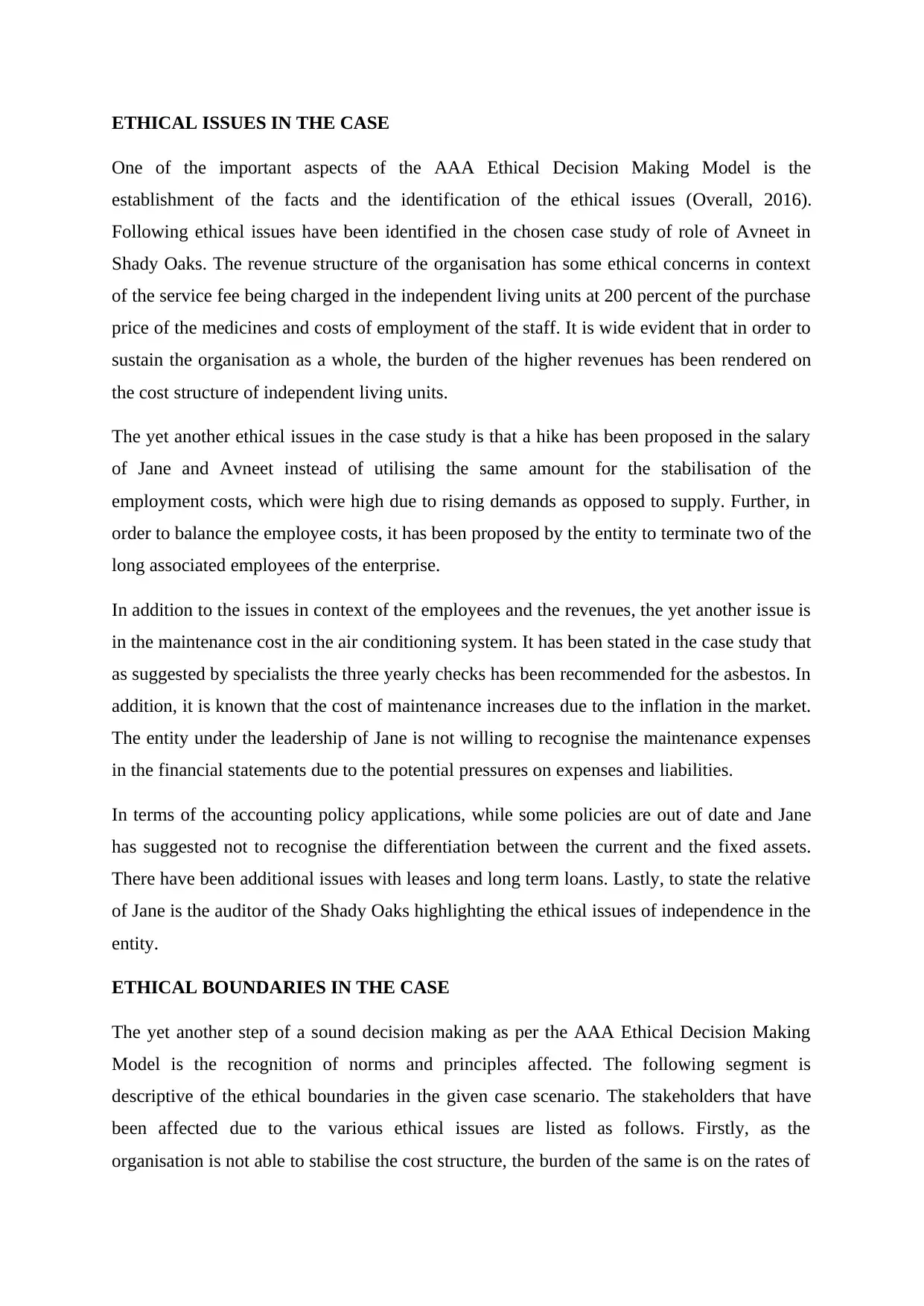
ETHICAL ISSUES IN THE CASE
One of the important aspects of the AAA Ethical Decision Making Model is the
establishment of the facts and the identification of the ethical issues (Overall, 2016).
Following ethical issues have been identified in the chosen case study of role of Avneet in
Shady Oaks. The revenue structure of the organisation has some ethical concerns in context
of the service fee being charged in the independent living units at 200 percent of the purchase
price of the medicines and costs of employment of the staff. It is wide evident that in order to
sustain the organisation as a whole, the burden of the higher revenues has been rendered on
the cost structure of independent living units.
The yet another ethical issues in the case study is that a hike has been proposed in the salary
of Jane and Avneet instead of utilising the same amount for the stabilisation of the
employment costs, which were high due to rising demands as opposed to supply. Further, in
order to balance the employee costs, it has been proposed by the entity to terminate two of the
long associated employees of the enterprise.
In addition to the issues in context of the employees and the revenues, the yet another issue is
in the maintenance cost in the air conditioning system. It has been stated in the case study that
as suggested by specialists the three yearly checks has been recommended for the asbestos. In
addition, it is known that the cost of maintenance increases due to the inflation in the market.
The entity under the leadership of Jane is not willing to recognise the maintenance expenses
in the financial statements due to the potential pressures on expenses and liabilities.
In terms of the accounting policy applications, while some policies are out of date and Jane
has suggested not to recognise the differentiation between the current and the fixed assets.
There have been additional issues with leases and long term loans. Lastly, to state the relative
of Jane is the auditor of the Shady Oaks highlighting the ethical issues of independence in the
entity.
ETHICAL BOUNDARIES IN THE CASE
The yet another step of a sound decision making as per the AAA Ethical Decision Making
Model is the recognition of norms and principles affected. The following segment is
descriptive of the ethical boundaries in the given case scenario. The stakeholders that have
been affected due to the various ethical issues are listed as follows. Firstly, as the
organisation is not able to stabilise the cost structure, the burden of the same is on the rates of
One of the important aspects of the AAA Ethical Decision Making Model is the
establishment of the facts and the identification of the ethical issues (Overall, 2016).
Following ethical issues have been identified in the chosen case study of role of Avneet in
Shady Oaks. The revenue structure of the organisation has some ethical concerns in context
of the service fee being charged in the independent living units at 200 percent of the purchase
price of the medicines and costs of employment of the staff. It is wide evident that in order to
sustain the organisation as a whole, the burden of the higher revenues has been rendered on
the cost structure of independent living units.
The yet another ethical issues in the case study is that a hike has been proposed in the salary
of Jane and Avneet instead of utilising the same amount for the stabilisation of the
employment costs, which were high due to rising demands as opposed to supply. Further, in
order to balance the employee costs, it has been proposed by the entity to terminate two of the
long associated employees of the enterprise.
In addition to the issues in context of the employees and the revenues, the yet another issue is
in the maintenance cost in the air conditioning system. It has been stated in the case study that
as suggested by specialists the three yearly checks has been recommended for the asbestos. In
addition, it is known that the cost of maintenance increases due to the inflation in the market.
The entity under the leadership of Jane is not willing to recognise the maintenance expenses
in the financial statements due to the potential pressures on expenses and liabilities.
In terms of the accounting policy applications, while some policies are out of date and Jane
has suggested not to recognise the differentiation between the current and the fixed assets.
There have been additional issues with leases and long term loans. Lastly, to state the relative
of Jane is the auditor of the Shady Oaks highlighting the ethical issues of independence in the
entity.
ETHICAL BOUNDARIES IN THE CASE
The yet another step of a sound decision making as per the AAA Ethical Decision Making
Model is the recognition of norms and principles affected. The following segment is
descriptive of the ethical boundaries in the given case scenario. The stakeholders that have
been affected due to the various ethical issues are listed as follows. Firstly, as the
organisation is not able to stabilise the cost structure, the burden of the same is on the rates of
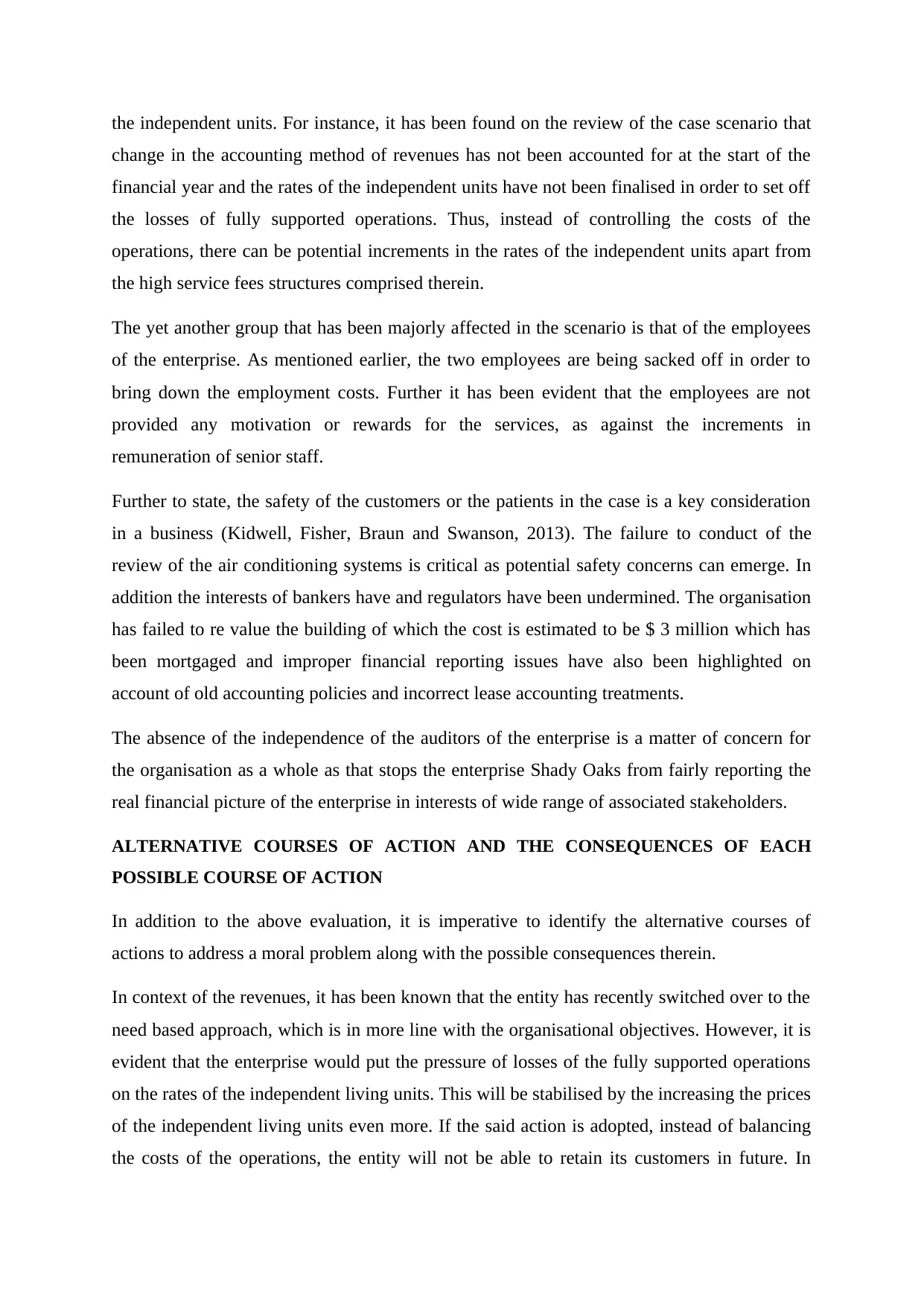
the independent units. For instance, it has been found on the review of the case scenario that
change in the accounting method of revenues has not been accounted for at the start of the
financial year and the rates of the independent units have not been finalised in order to set off
the losses of fully supported operations. Thus, instead of controlling the costs of the
operations, there can be potential increments in the rates of the independent units apart from
the high service fees structures comprised therein.
The yet another group that has been majorly affected in the scenario is that of the employees
of the enterprise. As mentioned earlier, the two employees are being sacked off in order to
bring down the employment costs. Further it has been evident that the employees are not
provided any motivation or rewards for the services, as against the increments in
remuneration of senior staff.
Further to state, the safety of the customers or the patients in the case is a key consideration
in a business (Kidwell, Fisher, Braun and Swanson, 2013). The failure to conduct of the
review of the air conditioning systems is critical as potential safety concerns can emerge. In
addition the interests of bankers have and regulators have been undermined. The organisation
has failed to re value the building of which the cost is estimated to be $ 3 million which has
been mortgaged and improper financial reporting issues have also been highlighted on
account of old accounting policies and incorrect lease accounting treatments.
The absence of the independence of the auditors of the enterprise is a matter of concern for
the organisation as a whole as that stops the enterprise Shady Oaks from fairly reporting the
real financial picture of the enterprise in interests of wide range of associated stakeholders.
ALTERNATIVE COURSES OF ACTION AND THE CONSEQUENCES OF EACH
POSSIBLE COURSE OF ACTION
In addition to the above evaluation, it is imperative to identify the alternative courses of
actions to address a moral problem along with the possible consequences therein.
In context of the revenues, it has been known that the entity has recently switched over to the
need based approach, which is in more line with the organisational objectives. However, it is
evident that the enterprise would put the pressure of losses of the fully supported operations
on the rates of the independent living units. This will be stabilised by the increasing the prices
of the independent living units even more. If the said action is adopted, instead of balancing
the costs of the operations, the entity will not be able to retain its customers in future. In
change in the accounting method of revenues has not been accounted for at the start of the
financial year and the rates of the independent units have not been finalised in order to set off
the losses of fully supported operations. Thus, instead of controlling the costs of the
operations, there can be potential increments in the rates of the independent units apart from
the high service fees structures comprised therein.
The yet another group that has been majorly affected in the scenario is that of the employees
of the enterprise. As mentioned earlier, the two employees are being sacked off in order to
bring down the employment costs. Further it has been evident that the employees are not
provided any motivation or rewards for the services, as against the increments in
remuneration of senior staff.
Further to state, the safety of the customers or the patients in the case is a key consideration
in a business (Kidwell, Fisher, Braun and Swanson, 2013). The failure to conduct of the
review of the air conditioning systems is critical as potential safety concerns can emerge. In
addition the interests of bankers have and regulators have been undermined. The organisation
has failed to re value the building of which the cost is estimated to be $ 3 million which has
been mortgaged and improper financial reporting issues have also been highlighted on
account of old accounting policies and incorrect lease accounting treatments.
The absence of the independence of the auditors of the enterprise is a matter of concern for
the organisation as a whole as that stops the enterprise Shady Oaks from fairly reporting the
real financial picture of the enterprise in interests of wide range of associated stakeholders.
ALTERNATIVE COURSES OF ACTION AND THE CONSEQUENCES OF EACH
POSSIBLE COURSE OF ACTION
In addition to the above evaluation, it is imperative to identify the alternative courses of
actions to address a moral problem along with the possible consequences therein.
In context of the revenues, it has been known that the entity has recently switched over to the
need based approach, which is in more line with the organisational objectives. However, it is
evident that the enterprise would put the pressure of losses of the fully supported operations
on the rates of the independent living units. This will be stabilised by the increasing the prices
of the independent living units even more. If the said action is adopted, instead of balancing
the costs of the operations, the entity will not be able to retain its customers in future. In
⊘ This is a preview!⊘
Do you want full access?
Subscribe today to unlock all pages.

Trusted by 1+ million students worldwide
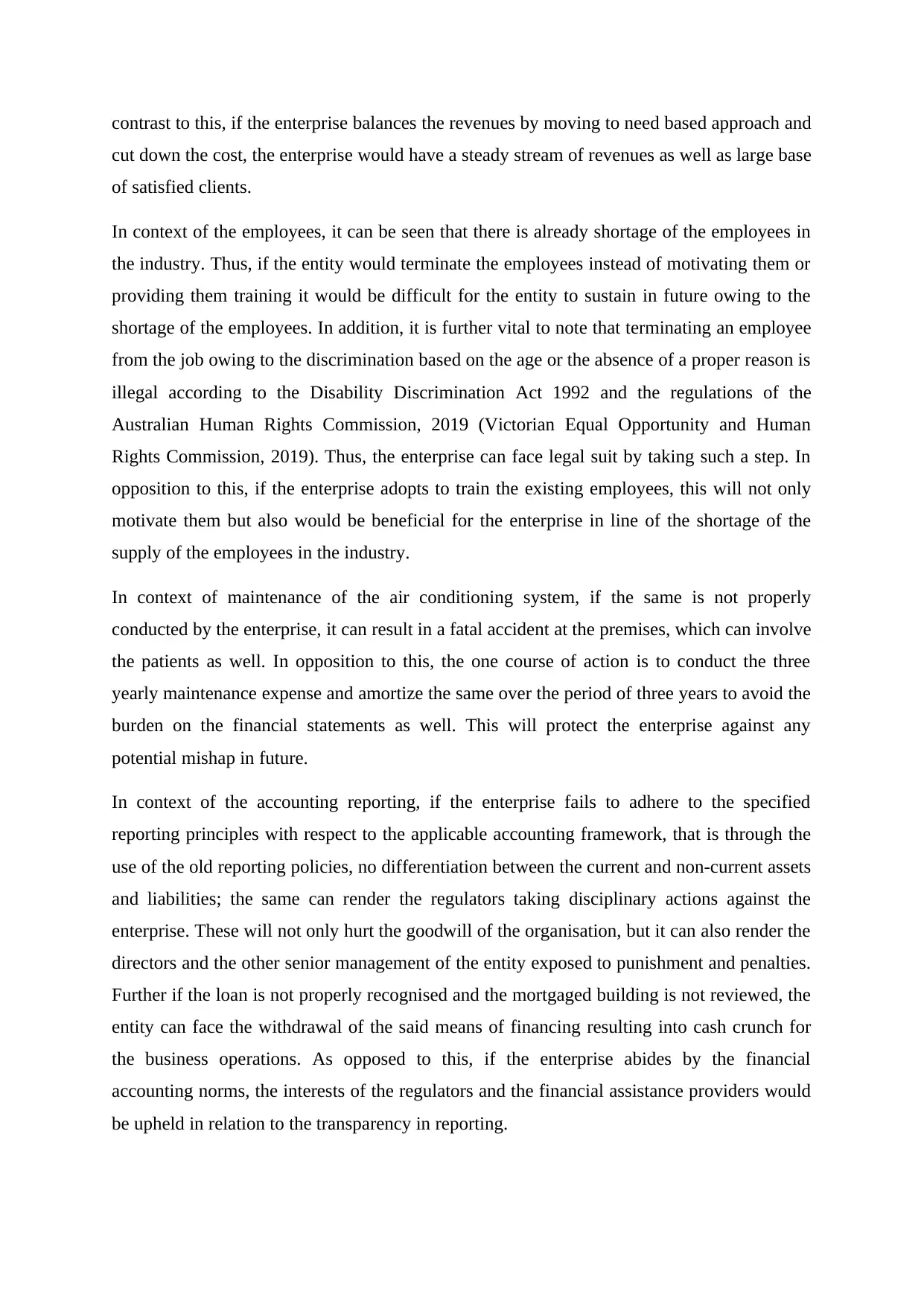
contrast to this, if the enterprise balances the revenues by moving to need based approach and
cut down the cost, the enterprise would have a steady stream of revenues as well as large base
of satisfied clients.
In context of the employees, it can be seen that there is already shortage of the employees in
the industry. Thus, if the entity would terminate the employees instead of motivating them or
providing them training it would be difficult for the entity to sustain in future owing to the
shortage of the employees. In addition, it is further vital to note that terminating an employee
from the job owing to the discrimination based on the age or the absence of a proper reason is
illegal according to the Disability Discrimination Act 1992 and the regulations of the
Australian Human Rights Commission, 2019 (Victorian Equal Opportunity and Human
Rights Commission, 2019). Thus, the enterprise can face legal suit by taking such a step. In
opposition to this, if the enterprise adopts to train the existing employees, this will not only
motivate them but also would be beneficial for the enterprise in line of the shortage of the
supply of the employees in the industry.
In context of maintenance of the air conditioning system, if the same is not properly
conducted by the enterprise, it can result in a fatal accident at the premises, which can involve
the patients as well. In opposition to this, the one course of action is to conduct the three
yearly maintenance expense and amortize the same over the period of three years to avoid the
burden on the financial statements as well. This will protect the enterprise against any
potential mishap in future.
In context of the accounting reporting, if the enterprise fails to adhere to the specified
reporting principles with respect to the applicable accounting framework, that is through the
use of the old reporting policies, no differentiation between the current and non-current assets
and liabilities; the same can render the regulators taking disciplinary actions against the
enterprise. These will not only hurt the goodwill of the organisation, but it can also render the
directors and the other senior management of the entity exposed to punishment and penalties.
Further if the loan is not properly recognised and the mortgaged building is not reviewed, the
entity can face the withdrawal of the said means of financing resulting into cash crunch for
the business operations. As opposed to this, if the enterprise abides by the financial
accounting norms, the interests of the regulators and the financial assistance providers would
be upheld in relation to the transparency in reporting.
cut down the cost, the enterprise would have a steady stream of revenues as well as large base
of satisfied clients.
In context of the employees, it can be seen that there is already shortage of the employees in
the industry. Thus, if the entity would terminate the employees instead of motivating them or
providing them training it would be difficult for the entity to sustain in future owing to the
shortage of the employees. In addition, it is further vital to note that terminating an employee
from the job owing to the discrimination based on the age or the absence of a proper reason is
illegal according to the Disability Discrimination Act 1992 and the regulations of the
Australian Human Rights Commission, 2019 (Victorian Equal Opportunity and Human
Rights Commission, 2019). Thus, the enterprise can face legal suit by taking such a step. In
opposition to this, if the enterprise adopts to train the existing employees, this will not only
motivate them but also would be beneficial for the enterprise in line of the shortage of the
supply of the employees in the industry.
In context of maintenance of the air conditioning system, if the same is not properly
conducted by the enterprise, it can result in a fatal accident at the premises, which can involve
the patients as well. In opposition to this, the one course of action is to conduct the three
yearly maintenance expense and amortize the same over the period of three years to avoid the
burden on the financial statements as well. This will protect the enterprise against any
potential mishap in future.
In context of the accounting reporting, if the enterprise fails to adhere to the specified
reporting principles with respect to the applicable accounting framework, that is through the
use of the old reporting policies, no differentiation between the current and non-current assets
and liabilities; the same can render the regulators taking disciplinary actions against the
enterprise. These will not only hurt the goodwill of the organisation, but it can also render the
directors and the other senior management of the entity exposed to punishment and penalties.
Further if the loan is not properly recognised and the mortgaged building is not reviewed, the
entity can face the withdrawal of the said means of financing resulting into cash crunch for
the business operations. As opposed to this, if the enterprise abides by the financial
accounting norms, the interests of the regulators and the financial assistance providers would
be upheld in relation to the transparency in reporting.
Paraphrase This Document
Need a fresh take? Get an instant paraphrase of this document with our AI Paraphraser
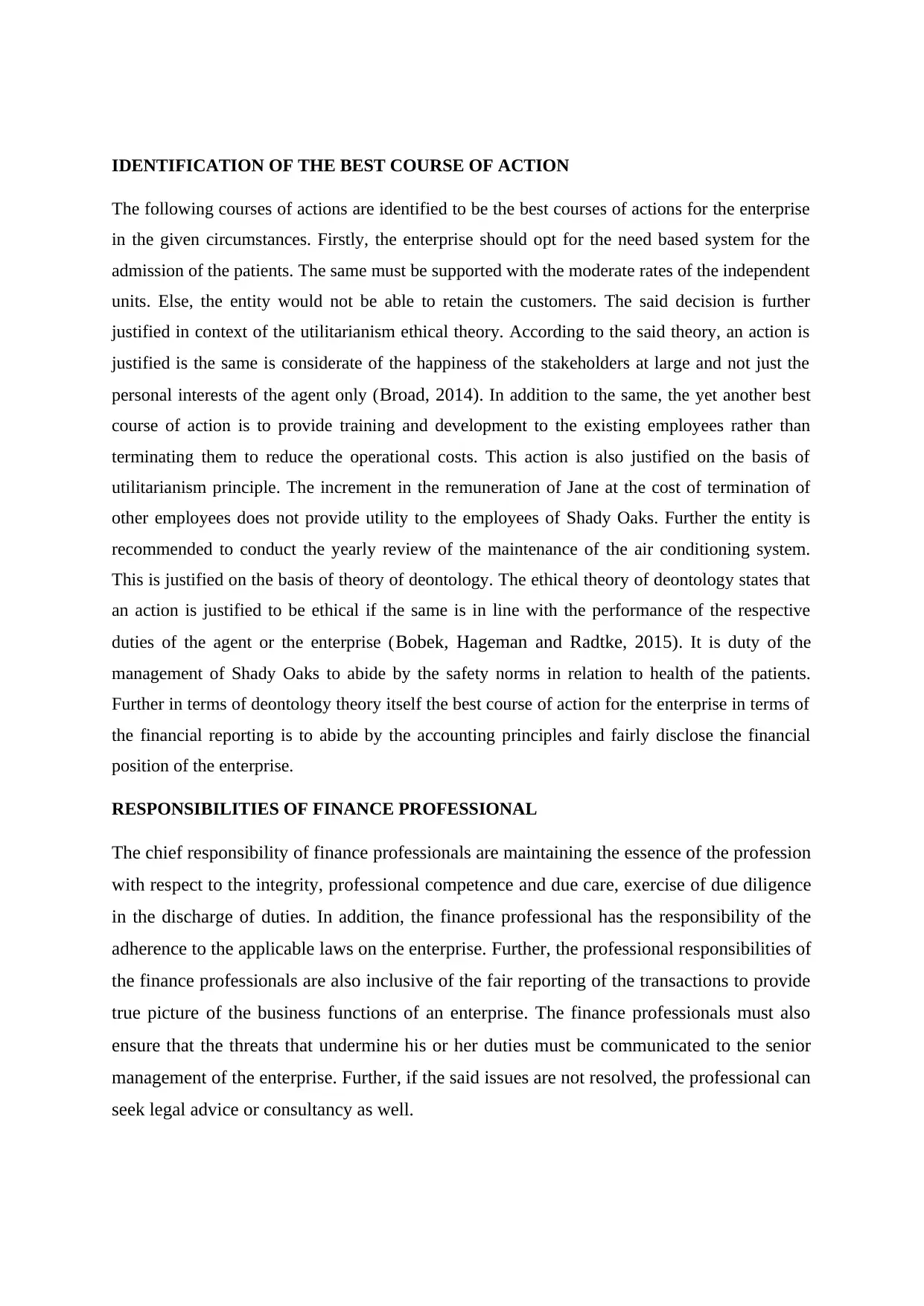
IDENTIFICATION OF THE BEST COURSE OF ACTION
The following courses of actions are identified to be the best courses of actions for the enterprise
in the given circumstances. Firstly, the enterprise should opt for the need based system for the
admission of the patients. The same must be supported with the moderate rates of the independent
units. Else, the entity would not be able to retain the customers. The said decision is further
justified in context of the utilitarianism ethical theory. According to the said theory, an action is
justified is the same is considerate of the happiness of the stakeholders at large and not just the
personal interests of the agent only (Broad, 2014). In addition to the same, the yet another best
course of action is to provide training and development to the existing employees rather than
terminating them to reduce the operational costs. This action is also justified on the basis of
utilitarianism principle. The increment in the remuneration of Jane at the cost of termination of
other employees does not provide utility to the employees of Shady Oaks. Further the entity is
recommended to conduct the yearly review of the maintenance of the air conditioning system.
This is justified on the basis of theory of deontology. The ethical theory of deontology states that
an action is justified to be ethical if the same is in line with the performance of the respective
duties of the agent or the enterprise (Bobek, Hageman and Radtke, 2015). It is duty of the
management of Shady Oaks to abide by the safety norms in relation to health of the patients.
Further in terms of deontology theory itself the best course of action for the enterprise in terms of
the financial reporting is to abide by the accounting principles and fairly disclose the financial
position of the enterprise.
RESPONSIBILITIES OF FINANCE PROFESSIONAL
The chief responsibility of finance professionals are maintaining the essence of the profession
with respect to the integrity, professional competence and due care, exercise of due diligence
in the discharge of duties. In addition, the finance professional has the responsibility of the
adherence to the applicable laws on the enterprise. Further, the professional responsibilities of
the finance professionals are also inclusive of the fair reporting of the transactions to provide
true picture of the business functions of an enterprise. The finance professionals must also
ensure that the threats that undermine his or her duties must be communicated to the senior
management of the enterprise. Further, if the said issues are not resolved, the professional can
seek legal advice or consultancy as well.
The following courses of actions are identified to be the best courses of actions for the enterprise
in the given circumstances. Firstly, the enterprise should opt for the need based system for the
admission of the patients. The same must be supported with the moderate rates of the independent
units. Else, the entity would not be able to retain the customers. The said decision is further
justified in context of the utilitarianism ethical theory. According to the said theory, an action is
justified is the same is considerate of the happiness of the stakeholders at large and not just the
personal interests of the agent only (Broad, 2014). In addition to the same, the yet another best
course of action is to provide training and development to the existing employees rather than
terminating them to reduce the operational costs. This action is also justified on the basis of
utilitarianism principle. The increment in the remuneration of Jane at the cost of termination of
other employees does not provide utility to the employees of Shady Oaks. Further the entity is
recommended to conduct the yearly review of the maintenance of the air conditioning system.
This is justified on the basis of theory of deontology. The ethical theory of deontology states that
an action is justified to be ethical if the same is in line with the performance of the respective
duties of the agent or the enterprise (Bobek, Hageman and Radtke, 2015). It is duty of the
management of Shady Oaks to abide by the safety norms in relation to health of the patients.
Further in terms of deontology theory itself the best course of action for the enterprise in terms of
the financial reporting is to abide by the accounting principles and fairly disclose the financial
position of the enterprise.
RESPONSIBILITIES OF FINANCE PROFESSIONAL
The chief responsibility of finance professionals are maintaining the essence of the profession
with respect to the integrity, professional competence and due care, exercise of due diligence
in the discharge of duties. In addition, the finance professional has the responsibility of the
adherence to the applicable laws on the enterprise. Further, the professional responsibilities of
the finance professionals are also inclusive of the fair reporting of the transactions to provide
true picture of the business functions of an enterprise. The finance professionals must also
ensure that the threats that undermine his or her duties must be communicated to the senior
management of the enterprise. Further, if the said issues are not resolved, the professional can
seek legal advice or consultancy as well.
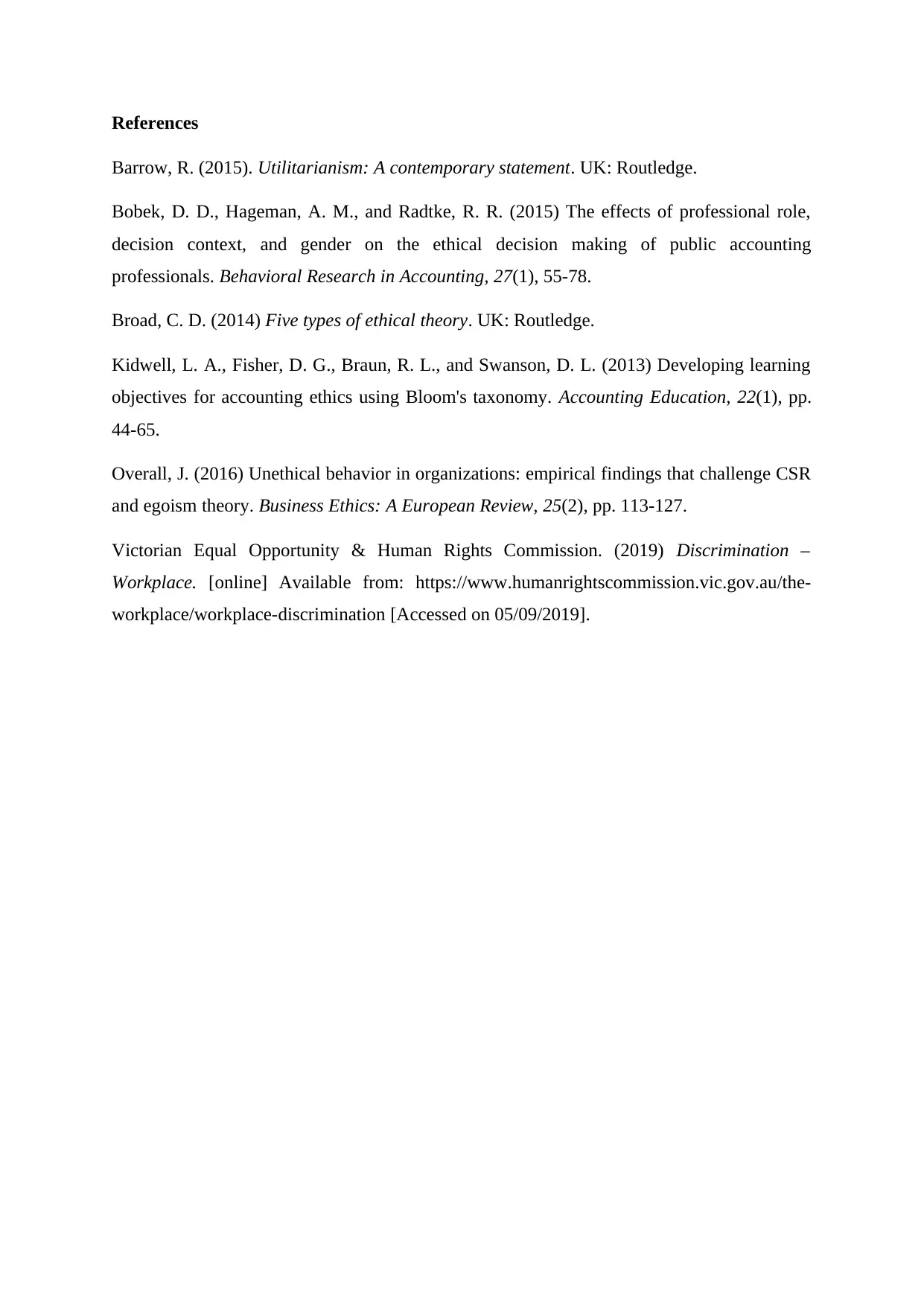
References
Barrow, R. (2015). Utilitarianism: A contemporary statement. UK: Routledge.
Bobek, D. D., Hageman, A. M., and Radtke, R. R. (2015) The effects of professional role,
decision context, and gender on the ethical decision making of public accounting
professionals. Behavioral Research in Accounting, 27(1), 55-78.
Broad, C. D. (2014) Five types of ethical theory. UK: Routledge.
Kidwell, L. A., Fisher, D. G., Braun, R. L., and Swanson, D. L. (2013) Developing learning
objectives for accounting ethics using Bloom's taxonomy. Accounting Education, 22(1), pp.
44-65.
Overall, J. (2016) Unethical behavior in organizations: empirical findings that challenge CSR
and egoism theory. Business Ethics: A European Review, 25(2), pp. 113-127.
Victorian Equal Opportunity & Human Rights Commission. (2019) Discrimination –
Workplace. [online] Available from: https://www.humanrightscommission.vic.gov.au/the-
workplace/workplace-discrimination [Accessed on 05/09/2019].
Barrow, R. (2015). Utilitarianism: A contemporary statement. UK: Routledge.
Bobek, D. D., Hageman, A. M., and Radtke, R. R. (2015) The effects of professional role,
decision context, and gender on the ethical decision making of public accounting
professionals. Behavioral Research in Accounting, 27(1), 55-78.
Broad, C. D. (2014) Five types of ethical theory. UK: Routledge.
Kidwell, L. A., Fisher, D. G., Braun, R. L., and Swanson, D. L. (2013) Developing learning
objectives for accounting ethics using Bloom's taxonomy. Accounting Education, 22(1), pp.
44-65.
Overall, J. (2016) Unethical behavior in organizations: empirical findings that challenge CSR
and egoism theory. Business Ethics: A European Review, 25(2), pp. 113-127.
Victorian Equal Opportunity & Human Rights Commission. (2019) Discrimination –
Workplace. [online] Available from: https://www.humanrightscommission.vic.gov.au/the-
workplace/workplace-discrimination [Accessed on 05/09/2019].
⊘ This is a preview!⊘
Do you want full access?
Subscribe today to unlock all pages.

Trusted by 1+ million students worldwide
1 out of 6
Related Documents
Your All-in-One AI-Powered Toolkit for Academic Success.
+13062052269
info@desklib.com
Available 24*7 on WhatsApp / Email
![[object Object]](/_next/static/media/star-bottom.7253800d.svg)
Unlock your academic potential
Copyright © 2020–2025 A2Z Services. All Rights Reserved. Developed and managed by ZUCOL.



